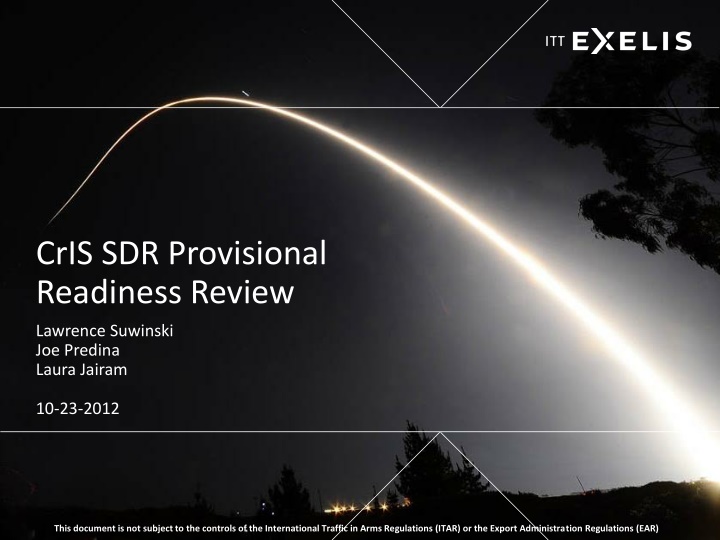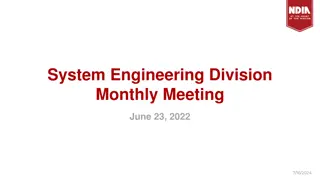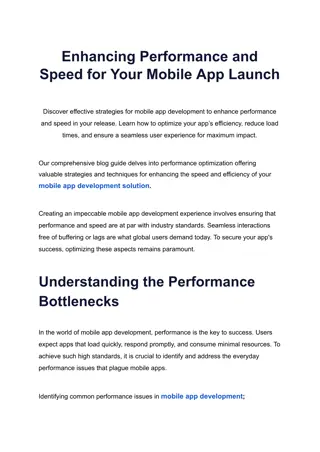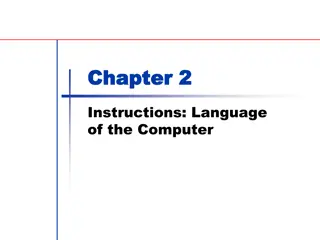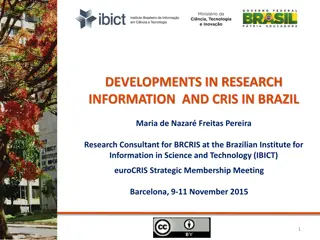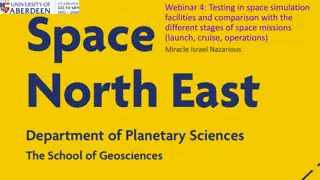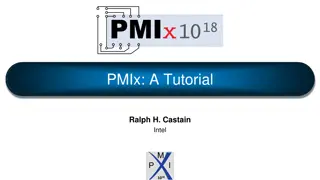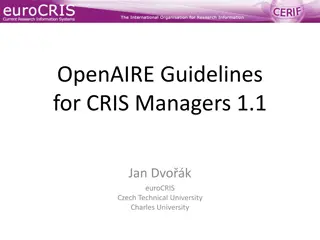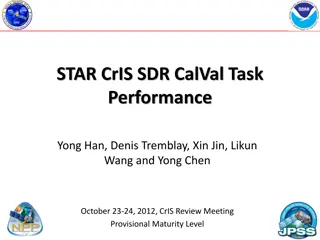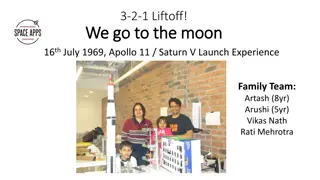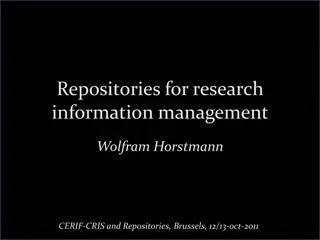Exelis Engineering Support for CrIS Post-Launch Operations
Exelis played a key role in providing support for the CrIS satellite instrument post-launch operations. The support included activities such as early orbit instrument checkout, calibration table uploads, and developing new algorithms for better data processing. Exelis also assisted in updating Engineering Packets to enhance the instrument's performance and accuracy. The collaboration with NOAA led to improved functionality and geolocation accuracy for the CrIS satellite system.
Download Presentation

Please find below an Image/Link to download the presentation.
The content on the website is provided AS IS for your information and personal use only. It may not be sold, licensed, or shared on other websites without obtaining consent from the author.If you encounter any issues during the download, it is possible that the publisher has removed the file from their server.
You are allowed to download the files provided on this website for personal or commercial use, subject to the condition that they are used lawfully. All files are the property of their respective owners.
The content on the website is provided AS IS for your information and personal use only. It may not be sold, licensed, or shared on other websites without obtaining consent from the author.
E N D
Presentation Transcript
CrIS SDR Provisional Readiness Review Lawrence Suwinski Joe Predina Laura Jairam 10-23-2012 This document is not subject to the controls of the International Traffic in Arms Regulations (ITAR) or the Export Administration Regulations (EAR)
Exelis Primary Roles During CrIS Post Launch Support 1) Early Orbit Instrument Checkout (10/28/11 2/8/12) > Instrument activation and functional checkout > On-site (at NSOF) and remote support from Fort Wayne > Engineering Packet #32 coordination & upload (2/8/12) > All EOC activities discussed at SDR Beta Review 2) Engineering Packet Calibration Table Uploads > Engineering Packet #33 coordination & upload (4/11/12) > Engineering Packet #34 coordination & upload (6/27/12) > Engineering Packet #35 (10/22/12) upload support 3) Additional support via NOAA SOW > Develop new FCE Algorithm that works for all scenes > Improve SDR Algorithm ICT environmental model > Train NOAA personnel on Engineering Packet upload process > Review instrument anomalies per SDR team lead request This document is not subject to the controls of the International Traffic in Arms Regulations (ITAR) or the Export Administration Regulations (EAR) 2
Exelis Support to Engineering Packet Updates Engineering Packet #33, 4/11/12 (Discussed at Beta Review) > ILS parameters best fit to atmospheric spectra > Nonlinearity parameters adjusted to provide best match of all 9 FOVs over a range of brightness temperatures > ICT emissivities smoothed to reduce retrieval noise Engineering Packet #34, 6/27/12 > Update temperature drift limits to reduce number of degraded spectra > Developed new thermal drift algorithm that was implemented in MX6.3 version of operational code > Details are in following slides Engineering Packet #35, 10/22/12 > Cooler stage 2 limit changed to 4K since readout circuit found to contain oscillation > Zeroed out interferometer boresight to SSMF angles > Provides more accurate geolocation > Exelis provided in-house training to NOAA/STAR personnel on packet creation and upload process This document is not subject to the controls of the International Traffic in Arms Regulations (ITAR) or the Export Administration Regulations (EAR) 4
SDR Algorithm Monitors Several Temperatures for Excessive Drift CrIS Engineering Packet contains temperature drift rate limits used by SDR Algorithm for Degraded SDR quality flag SDR flagged degraded if one or more thermal drifts exceeds limit within 4 minute moving window Four thermal drift limits are regularly exceeded on- orbit ICT Temp #1 ICT Temp #2 Stage 3 cooler Stage 4 cooler Two Minute Temperature Drift Limit (Engineering Packet #33) ICT temp #1 ICT temp #2 Beamsplitter temp #1 Scan mirror temp Scan baffle temp OMA structure #1 OMA structure #2 Telescope Stage 1 cooler Stage 2 cooler Stage 3 cooler Stage 4 cooler 0.06 K 0.06 K 0.2 K 1.3 K 1.7 K 0.2 K 0.2 K 0.2 K 0.3 K 1.0 K 0.025 K 0.025 K This document is not subject to the controls of the International Traffic in Arms Regulations (ITAR) or the Export Administration Regulations (EAR) 5
Example: Stage 3 Cooler Temperature Drift Consistently Exceeded Limits Drift Calculated During 30 Sample Moving Window [Max Min] Same large scale outages as ICT Plot provided by NGAS Drift (Kelvin) Many low level noise triggered outages Sample Number This document is not subject to the controls of the International Traffic in Arms Regulations (ITAR) or the Export Administration Regulations (EAR) 6 6
SDR Degraded QC Flag Found to Undergo High False Alarm Rate Due to Four Problems 1. Engineering Packet #33 temperature drift limits not correct > Results in QC flag triggered at lower level than intended Fixed by Updating Engineering Packet (#34) 2. SDR algorithm uses 4 minute window to calculate drift instead of 2 minutes Results in a calculated drift 2 times too large > 3. SDR algorithm method not robust against temperature telemetry noise Algorithm is sensitive to noise peaks > 4. Linear thermal drift calculated by SDR Algorithm not consistent with instrument performance Fixed by Replacing [Max Min] Algorithm with Better Noise Robust Algorithm Drift rate algorithm needs to distinguish between linear and nonlinear drift > Apex- Earth-Scene Measurement Effective Maximum Deviation Maximum Drift Rate calibration cycle This document is not subject to the controls of the International Traffic in Arms Regulations (ITAR) or the Export Administration Regulations (EAR) 7 7
Temperature Drift Limits Were Updated in Engineering Packet #34 to Reduce Spectra Flagged as Degraded Engineering Packet #34 Two Minute Temperature Drift Limit Engineering Packet #33 Two Minute Temperature Drift Limit ICT temp #1 0.12 K ICT temp #1 ICT temp #2 Beamsplitter temp #1 Scan mirror temp Scan baffle temp OMA structure #1 OMA structure #2 Telescope Stage 1 cooler Stage 2 cooler Stage 3 cooler Stage 4 cooler 0.06 K 0.06 K 0.2 K 1.3 K 1.7 K 0.2 K 0.2 K 0.2 K 0.3 K 1.0 K 0.025 K 0.025 K ICT temp #2 0.12 K Beamsplitter temp #1 0.5 K Scan mirror temp 1.3 K Scan baffle temp 1.7 K OMA structure #1 0.5 K Updated to this OMA structure #2 0.5 K Telescope 0.5 K Stage 1 cooler 0.25 K Stage 2 cooler 1.0 K Stage 3 cooler 0.05 K Stage 4 cooler 0.05 K Corresponds to Current NPP CrIS Sensor Specification This document is not subject to the controls of the International Traffic in Arms Regulations (ITAR) or the Export Administration Regulations (EAR) 8
Better Algorithm Was Needed for Identifying Temperature Drifts Having Most Negative Impact on Performance Data Set Available 30 temperature samples spanning 4 minute window 15 prior & 15 after earth scene of interest ~10 mK rms random noise per sample Objective Flag thermal drift conditions that produce a calibration bias Average window temperature different than center of window temperature Robust to telemetry random and spike noise Magnitude of calibration error (% uncertainty) exceeds basis of analysis for CrIS thermal Drift specification Examples of Thermal Drift Average Average Average Type 2 Occasional Type 3 Rare Type 1 Most Common Calibration Impact .half of Type 3 Calibration Impact .Worst Case Used for CrIS Sensor Specification Calibration Impact .. Negligible This document is not subject to the controls of the International Traffic in Arms Regulations (ITAR) or the Export Administration Regulations (EAR) 9
New Thermal Drift Algorithm Eliminates Unnecessary Degraded Spectra Trigger Degraded QC flag when ( ) ( ) + 2 first eight samples last eight samples TLimit Median Median ( ) center fourteen samples ABS Median 2 ( ) ( ) + , , , , , , , , , , , , , , TLimit Median T T T T T T T T Median T T T T T T T T ( ) 1 2 3 4 5 6 7 8 23 24 25 26 27 28 29 30 , , , , , , , , , , , , , ABS Median T T T T T T T T T T T T T T 9 10 11 12 13 14 15 16 17 18 19 20 21 22 2 2 Limit T Where: = temperature telemetry drift limit for 2 minutes (from engineering packet) iT = temperature of ithsample in moving window (from science telemetry packet) Note: for ICT PRT1 & ICT PRT2 this value is an average of 40 temperature samples reported in science telemetry packet Triggers flag when twice engineering packet drift rate limit exceeded Triggers flag when engineering packet drift rate limit exceeded Never triggers flag Limit T 4 Limit T 2 Type 2 Type 1 Type 3 Algorithm Implemented in MX6.3 Operational Code This document is not subject to the controls of the International Traffic in Arms Regulations (ITAR) or the Export Administration Regulations (EAR) 10
Exelis Funded to Perform Additional Cal/Val Tasks SOW provided from 5/14/12 through 1/31/13 Description of work includes: > Developing better Fringe Count Error (FCE) detection and correction algorithm > Develop improved ICT environmental model for SDR Algorithm > Improve scan baffle temperature model for SDR Algorithm > Collaborate with other team members regarding additional SDR Algorithm improvements > Reorder application of radiometric calibration and spectral corrections > Support Engineering Packet #34 and #35 release and upload (covered in previous slides) > Provide training to NOAA personnel on Engineering Packet creation and upload process > Perform anomaly investigation and resolution per SDR team lead discretion > Participate in weekly telecons and Product Review meetings Details Discussed in Following Slides This document is not subject to the controls of the International Traffic in Arms Regulations (ITAR) or the Export Administration Regulations (EAR) 12
FCE Algorithm Background Current FCE detection scheme does not work for earth scenes that are at or below the instrument background level > Current ICT/DS detection and correction methodology works since phase in reference scenes is relatively constant > ES phases vary and large percentage of scenes are declared degraded due to inability to identify presence of FCEs > FCE detection/correction currently turned off in operational code Goal of new algorithm is twofold: Have the ability to detect and correct FCEs in all earth scenes, regardless of scene Retain functional algorithm for ICT/DS scenes 1. 2. New FCE algorithm developed, implemented and tested in Matlab > Simple bin-counting threshold provides 100% detection with no false alarms > Diagnostic data test bed developed to simulate FCE injection > Algorithm is able to detect and correct for loss of -18 to +18 fringes with less than 1 mK of residual error in all cases This document is not subject to the controls of the International Traffic in Arms Regulations (ITAR) or the Export Administration Regulations (EAR) 14
FCE Detection/Correction Flow Implemented in Matlab On-Orbit Diagnostic Data Diagnostic Data Used As Input to Simulate FCEs, Test Algorithm and Establish/Verify Thresholds FCE Simulation Code This document is not subject to the controls of the International Traffic in Arms Regulations (ITAR) or the Export Administration Regulations (EAR) 15
Detection Methodology Influenced by Several Factors Detection algorithm uses LWIR FOV5 as initial indication of possible FCE presence Exelis SDR Algorithm rewritten to process all 9 FOVs in parallel > Provides large speed enhancement > Means only 1 band is needed for FCE detection Low signal interferograms pose challenging detection cases > Implementing a bin counting scheme allows for 100% detection with no false alarms > Schemes using a mean value found not to be 100% reliable FOV-to-FOV variations seen in LWIR imaginary components for FCE=0 cases > Detection performed on well behaved FOV5 > FCE magnitude determination performed for all FOVs > Data marked invalid if all FOVs do not agree on FCE magnitude > FCE=0 case included in magnitude determination to further eliminate false alarms This document is not subject to the controls of the International Traffic in Arms Regulations (ITAR) or the Export Administration Regulations (EAR) 16
Certain FCE Numbers Create Difficult Detection Cases Longwave Imaginary component, Hardest detection case in Orbit 1300, FCE = 6 Using only this range, the two are nearly identical Wavenumber range used in detection: 650-1075cm-1 50 bins with |Im (650-1075)| > 1 radiance = FCE detected This document is not subject to the controls of the International Traffic in Arms Regulations (ITAR) or the Export Administration Regulations (EAR) 17
Testing Across FOVs Reveal FOV False Alarm Dependency Maximum # of Bins Over 1 radiance in Single Spectrum, 8-19-2012 50 bin threshold Applied the new FCE detection scheme to a day of LWIR operational SDRs No false alarms on 8 of 9 FOVs FOV6 had 9 false alarms This document is not subject to the controls of the International Traffic in Arms Regulations (ITAR) or the Export Administration Regulations (EAR) 18
Dependency Traced to Differing Imaginary Signatures FOV6 profile has significant non-zero features Will use FOV5 for FCE detection, with a back up FOV FOV5 confirmed to work for NPP This document is not subject to the controls of the International Traffic in Arms Regulations (ITAR) or the Export Administration Regulations (EAR) 19
FCE Detection Rate Results for FOV5 Show 100% Detection Injected FCE using Matlab testbed Perfect detection and no false alarms on test orbit - Only FOV 5 tested, FOR 1 & 15 both had same results This document is not subject to the controls of the International Traffic in Arms Regulations (ITAR) or the Export Administration Regulations (EAR) 20
Mean RMS Errors for Full Orbit Demonstrate Correction to <1 mK Minimal FOR dependency observed in RMS errors This document is not subject to the controls of the International Traffic in Arms Regulations (ITAR) or the Export Administration Regulations (EAR) 21
FCE Algorithm Summary Exelis has developed an algorithm to reliably detect and correct FCEs of magnitudes from -18 to +18 > Reference scene FCE algorithm remains same as operational > ES algorithm now detects and corrects FCEs for all scenes > If LWIR FOV5 contains >50 bins above 1 r.u., FCE is detected > All LWIR FOVs phase corrected from -18 to +18 FCE to find imaginary component minima > If FOVs agree on magnitude, reference scene windows are aligned to the ES > If FOVs do not agree, spectra are marked invalid Diagnostic data used to simulate FCEs and validate the detection/correction algorithms > Detection is 100% with no false alarms > Resulting corrections match expected to <1 mK Algorithm currently being implemented into Exelis SDR code This document is not subject to the controls of the International Traffic in Arms Regulations (ITAR) or the Export Administration Regulations (EAR) 22
ICT Model Temperature Inputs Trended and Reviewed ICT, scan baffle, OMA and beamsplitter temperatures reviewed over a 50 orbit data set and trended monthly > Idea is to use trended data to correlate Exelis thermal model and provide better scan baffle profile > 10 orbit profiles from 1st day of each month trended from February through September > Scan baffle profiles shown here; remainder of data in Appendix Inherent variations seen in temperature profiles that limit effectiveness of ICT model or scan baffle improvements > Profiles are not very repeatable orbit-to-orbit or seasonally Revised environmental model not needed for J1 > 3-bounce trap ICT eliminates need for most of model > Current model will have view factor for cold beamsplitter set to 1, all others set to 0 > Will ensure proper calculation of the ICT radiance based on specular reflection of cold beamsplitter view This document is not subject to the controls of the International Traffic in Arms Regulations (ITAR) or the Export Administration Regulations (EAR) 24
Scan Baffle Temperature Shows Larger Variation Near Equator Regions Following Equator Overpasses Contain Higher Variation This document is not subject to the controls of the International Traffic in Arms Regulations (ITAR) or the Export Administration Regulations (EAR) 25
Averaged Profiles Reveal Up to 1.5K Variation by Orbit This document is not subject to the controls of the International Traffic in Arms Regulations (ITAR) or the Export Administration Regulations (EAR) 26
Standard Deviation Also Larger Following Equator Crossing Data Following Ascending Equator Crossing is Most Noisy This document is not subject to the controls of the International Traffic in Arms Regulations (ITAR) or the Export Administration Regulations (EAR) 27
Scan Baffle 10 Orbit Overlays Not Very Repeatable Scan Baffle Correction Profile to Be Further Reviewed for Future Adjustments Overlays of Other Temperatures Can Be Reviewed in Appendix This document is not subject to the controls of the International Traffic in Arms Regulations (ITAR) or the Export Administration Regulations (EAR) 28
Reordering of Radiometric Calibration and Spectral Corrections
Differences Between Ordering of Radiometric Calibration and Spectral Corrections Evaluated Reversal of ordering is desired since it will improve SDR Algorithm execution speed > No FINT matrix multiplication required for ILS correction > Need for post-calibration filter also removed > Removes matrix multiplication from CMO calculation Orders implemented and compared using: > TVAC4 Scan Scenario data > On-orbit data from 7-21-2012 Differences between orders evaluated and plotted > Percent differences ratioed to 287K BB > Straight differences Differences seen to be larger for scenes with spectral content > Results are similar to MIT-LL analysis This document is not subject to the controls of the International Traffic in Arms Regulations (ITAR) or the Export Administration Regulations (EAR) 30
Impact of Reordering Spectral/Radiometric Calibrations in SDR Algorithm Evaluated by Exelis Current Order, v2.20 of SDR Algorithm: Sort Data and FCE Radiometric Cal (with FINT) Bandpass Filter Resampling to User Grid RDRs DFT ILS Corrections and User Apodization Geolocation SDRs Proposed Order, Including New ES FCE Method: Sort Data and ICT/DS FCE Resampling to User Grid ILS Corrections and User Apodization RDRs DFT Radiometric Cal (no FINT) Boxes in Blue Are Changed From Current Order ES FCE Geolocation SDRs This document is not subject to the controls of the International Traffic in Arms Regulations (ITAR) or the Export Administration Regulations (EAR) 31
Comparison of Order Using TVAC Blackbody Data Shows < 0.03% Impact Matches Very Closely, Except Near Extreme LWIR Band Edge This document is not subject to the controls of the International Traffic in Arms Regulations (ITAR) or the Export Administration Regulations (EAR) 32
Up to 0.5% Difference Seen When Analyzing On-Orbit Structured Scenes Larger Differences Seen in Structured Scene This document is not subject to the controls of the International Traffic in Arms Regulations (ITAR) or the Export Administration Regulations (EAR) 33
Radiance Differences Show Actual Change in Values is Small Difference Less Than NEdN In Most Cases This document is not subject to the controls of the International Traffic in Arms Regulations (ITAR) or the Export Administration Regulations (EAR) 34
PCF/No PCF Comparison Demonstrates Filter Is Not Needed With New Calibration Order This document is not subject to the controls of the International Traffic in Arms Regulations (ITAR) or the Export Administration Regulations (EAR) 35
Summary Differences between current and proposed order evaluated > On-orbit data shows difference on the order of the detector NEdN specs Needs for post-cal filter and FINT matrix eliminated with change Change in order and elimination of filter implemented in Exelis SDR code Plan is to continue to collaborate with team regarding other SDR Algorithm improvements > Self-apodization correction > Spectral resampling > Improved calibration performance at band edges This document is not subject to the controls of the International Traffic in Arms Regulations (ITAR) or the Export Administration Regulations (EAR) 36
Exelis Involvement in Anomaly Investigation Exelis has been involved in several anomaly investigations One will be discussed in this review > Root cause determination of on-orbit responsivity variation first reported by UW Other anomalies/investigations will be briefed by various team members This document is not subject to the controls of the International Traffic in Arms Regulations (ITAR) or the Export Administration Regulations (EAR) 38
Responsivity Variation Reported by UW Confirmed to Be Present in TVAC Data UW Will Discuss On- Orbit Findings This document is not subject to the controls of the International Traffic in Arms Regulations (ITAR) or the Export Administration Regulations (EAR) 39
Simulation of Optical Coating Introducing an 11 m Delay Matches On-Orbit Observations Percent Variations and Null Wavenumbers Match On-Orbit Variations Very Well; Channeling is Root Cause Wavenumber Channeling Effect Calibrates Out and Does Not Affect SDR Performance This document is not subject to the controls of the International Traffic in Arms Regulations (ITAR) or the Export Administration Regulations (EAR) 40
Exelis SDR Provisional Summary Exelis has and continues to work on agreed tasking: > SDR Algorithm improvements > Engineering packet support > Anomaly investigations Will continue to work with SDR team regarding future SDR improvements Exelis considers CrIS SDRs ready for Provisional Status This document is not subject to the controls of the International Traffic in Arms Regulations (ITAR) or the Export Administration Regulations (EAR) 42
ICT Temperature Overlays, 43 Orbits ICT Profiles Are Relatively Stable This document is not subject to the controls of the International Traffic in Arms Regulations (ITAR) or the Export Administration Regulations (EAR) 44
ICT Min/Max/Average Profile This document is not subject to the controls of the International Traffic in Arms Regulations (ITAR) or the Export Administration Regulations (EAR) 45
ICT Standard Deviation Peak Seen In Similar Location to Scan Baffle Peak This document is not subject to the controls of the International Traffic in Arms Regulations (ITAR) or the Export Administration Regulations (EAR) 46
ICT 10 Orbit Overlays February Results High For Most Telemetry; Instrument Activation Activities Performed During This Time This document is not subject to the controls of the International Traffic in Arms Regulations (ITAR) or the Export Administration Regulations (EAR) 47
OMA Temperature Overlays, 43 Orbits Profiles Are Stable This document is not subject to the controls of the International Traffic in Arms Regulations (ITAR) or the Export Administration Regulations (EAR) 48
OMA Min/Max/Average Profile This document is not subject to the controls of the International Traffic in Arms Regulations (ITAR) or the Export Administration Regulations (EAR) 49
OMA Standard Deviation Small Peak Seen This document is not subject to the controls of the International Traffic in Arms Regulations (ITAR) or the Export Administration Regulations (EAR) 50
